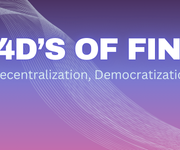The Sublimation of Society: Blockchain’s Role in a Phase Transition to Decentralization
In the natural world, sublimation is a fascinating process where a solid transitions directly into a gas, skipping the liquid phase entirely. This phenomenon can serve as a powerful metaphor for the transformative shift society is experiencing due to the advent of blockchain technology. Just as sublimation represents a leap from one state to another, blockchain is enabling society to bypass traditional organizational structures and move towards a more decentralized and transparent model.
Solid Societal Structures
For centuries, societal structures have been solidified into hierarchical systems characterized by centralized authority and top-down governance. From governments to corporations, these structures have been the bedrock of societal organization, providing stability and order but often at the cost of flexibility and individual empowerment. While effective in many ways, this rigidity can lead to inefficiency, corruption, and disenfranchisement, prompting a search for alternatives.
Adding Heat
The ‘heat’ in this context comes from the increasing dissatisfaction with traditional systems and the growing demand for more transparency, equality, and participation in societal mechanisms. Blockchain technology has emerged as a significant agent of change in this landscape, challenging the status quo and offering a new way to organize and govern. Like thermal energy causing a solid to sublimate, blockchain is adding the necessary energy to disrupt established systems, making way for a new phase of societal organization.
Phase Transition to Decentralization
Blockchain facilitates a direct transition from centralized to decentralized structures, mirroring the process of sublimation. This technology allows for the creation of decentralized networks where power and control are distributed across all participants rather than concentrated in the hands of a few. This shift is not merely a change of tools but a fundamental reimagining of how society can organize, collaborate, and make decisions. The transition to decentralization, powered by blockchain, is redefining concepts of authority, trust, and community.
The New Gas
In this new ‘gaseous’ state, decentralized autonomous organizations (DAOs) represent the molecules moving freely, without the constraints of traditional hierarchical structures. DAOs are an embodiment of the decentralized ethos, operating on blockchain technology to enable collective decision-making and resource management without centralized control. This new societal framework allows for more fluid, dynamic, and democratic forms of organization, where the barriers between leaders and contributors are minimized, and collective goals drive actions.
Condensation Challenges
However, transitioning too quickly from solid to gas without passing through the liquid phase can lead to ‘condensation’ challenges. In societal terms, this refers to the difficulties and criticisms associated with moving too rapidly towards decentralization. These can include issues of governance, scalability, legal recognition, and security. The novelty of decentralized systems means that there are still many unknowns, and the lack of centralized control can lead to fragmentation and coordination problems. Addressing these challenges requires careful consideration, innovative solutions, and perhaps most importantly, time for society to adjust and for the new systems to mature.
Equilibrium and Adoption
The ultimate goal is to find a sustainable balance between the old and the new, where decentralized and traditional structures coexist and complement each other. Achieving this equilibrium means integrating the transparency, efficiency, and inclusivity of decentralized systems with the stability, experience, and regulatory frameworks of traditional structures. Adoption will be a gradual process, requiring education, experimentation, and a willingness to adapt. As society learns to navigate this new landscape, the principles of blockchain — transparency, security, and decentralization — can help guide the development of systems that are more resilient, equitable, and aligned with the values of a modern, interconnected world.
The transition society is undergoing, facilitated by blockchain technology, can be likened to the process of sublimation. It is a leap into a new state of organization and governance that offers significant opportunities for empowerment, efficiency, and transparency. However, just as in the natural world, this phase transition comes with its challenges and uncertainties. By understanding and addressing these issues, society can harness the full potential of blockchain, paving the way for a more decentralized, equitable, and innovative future.





